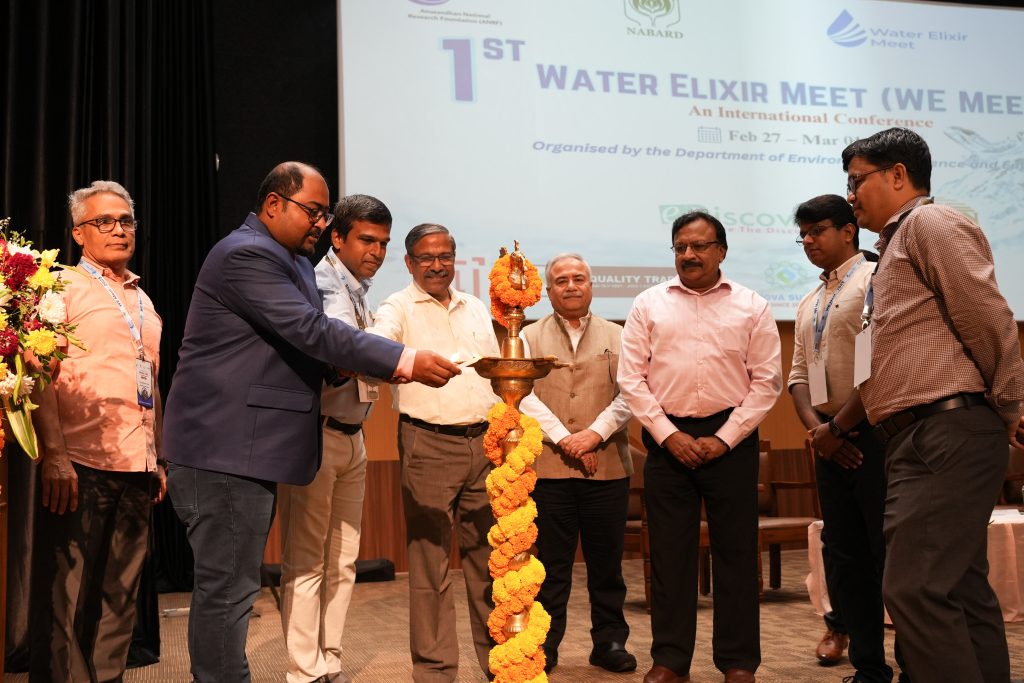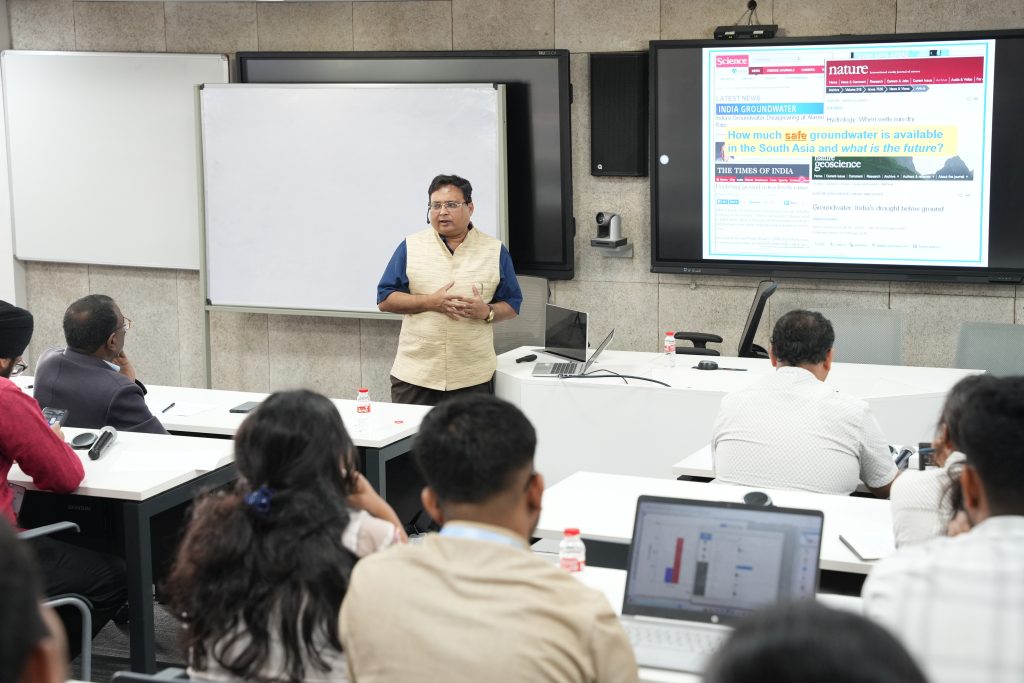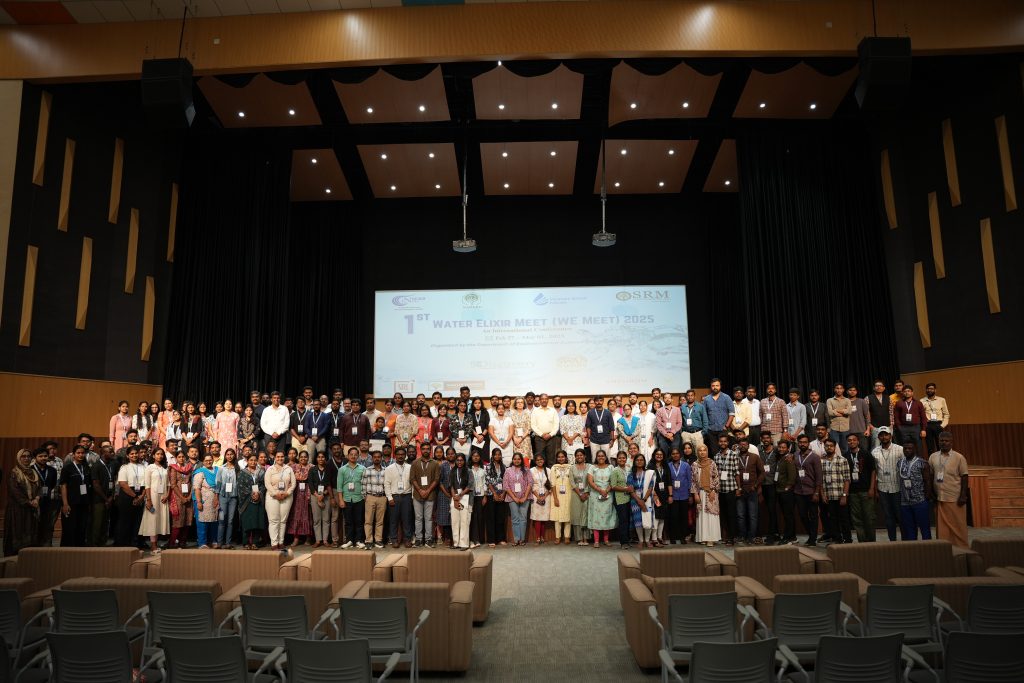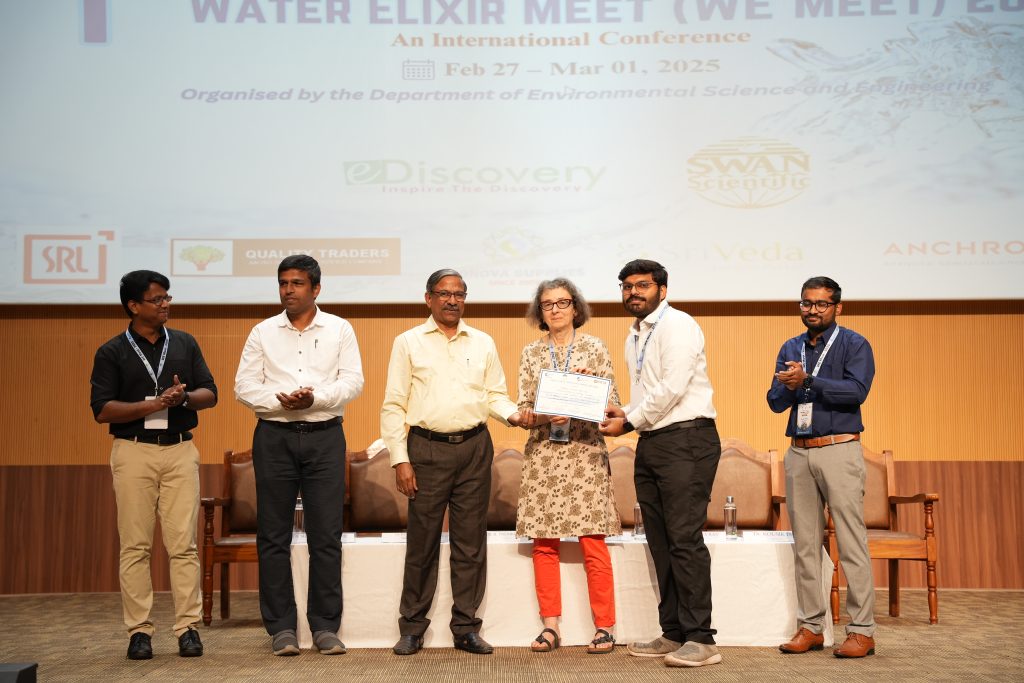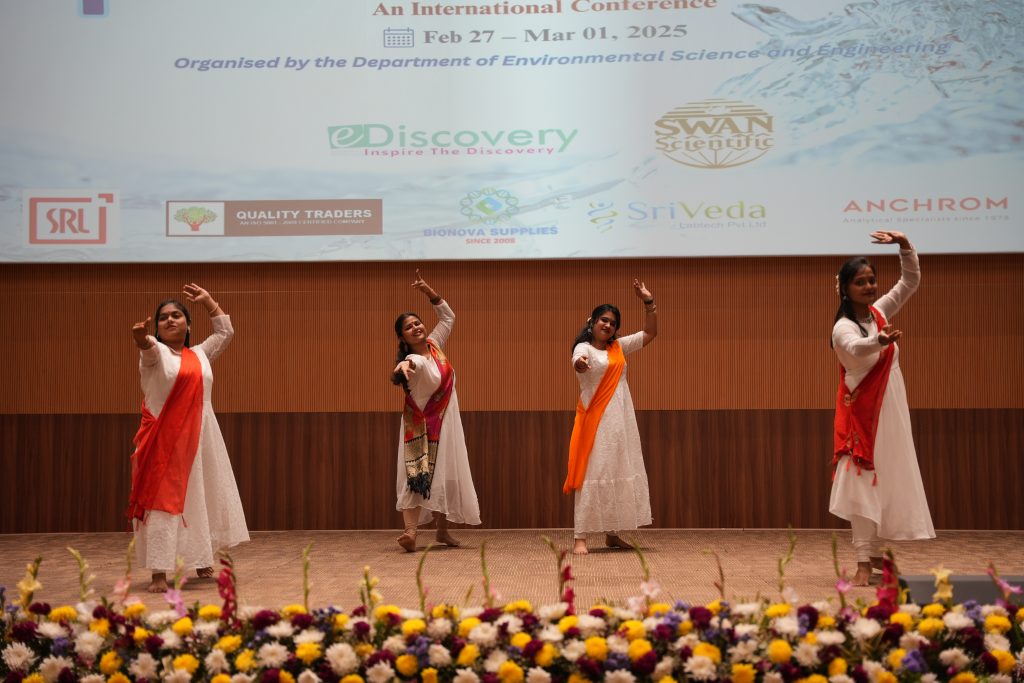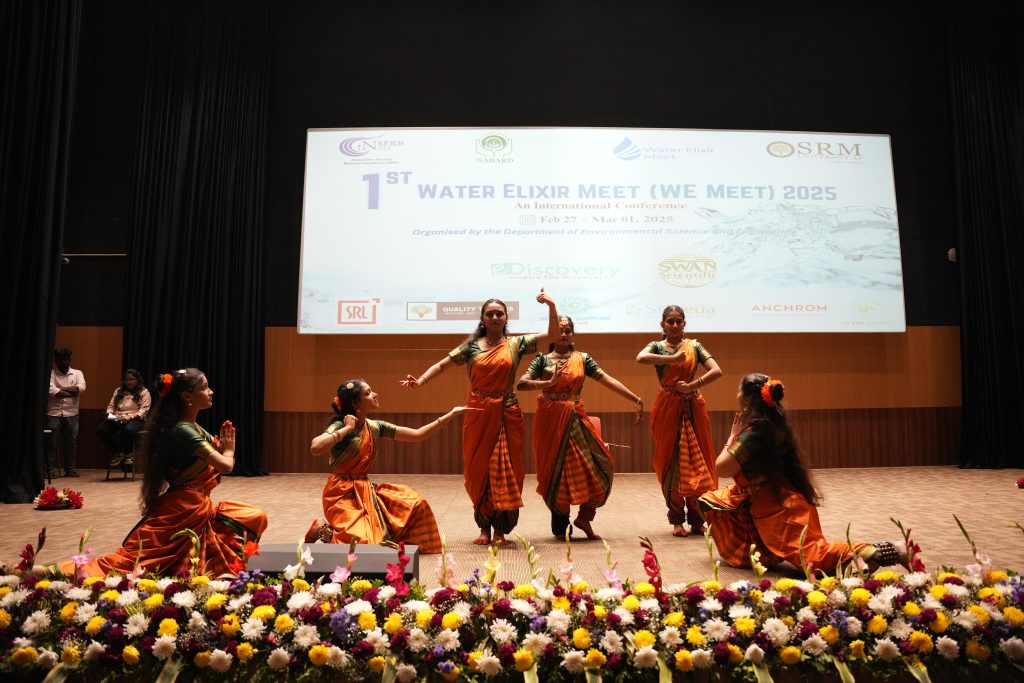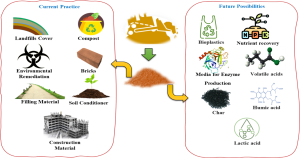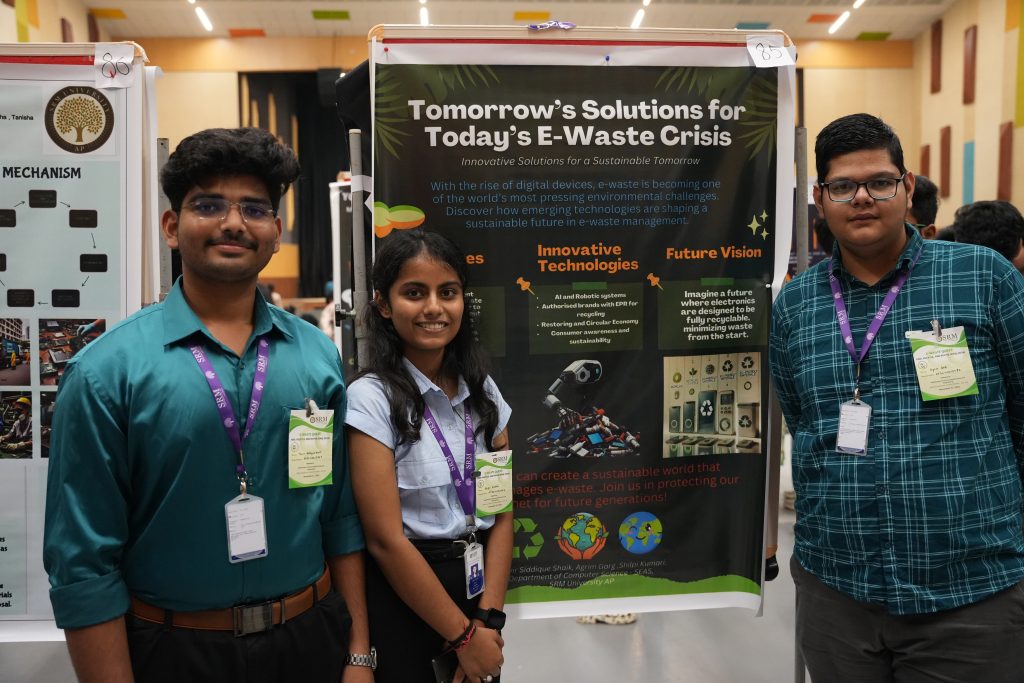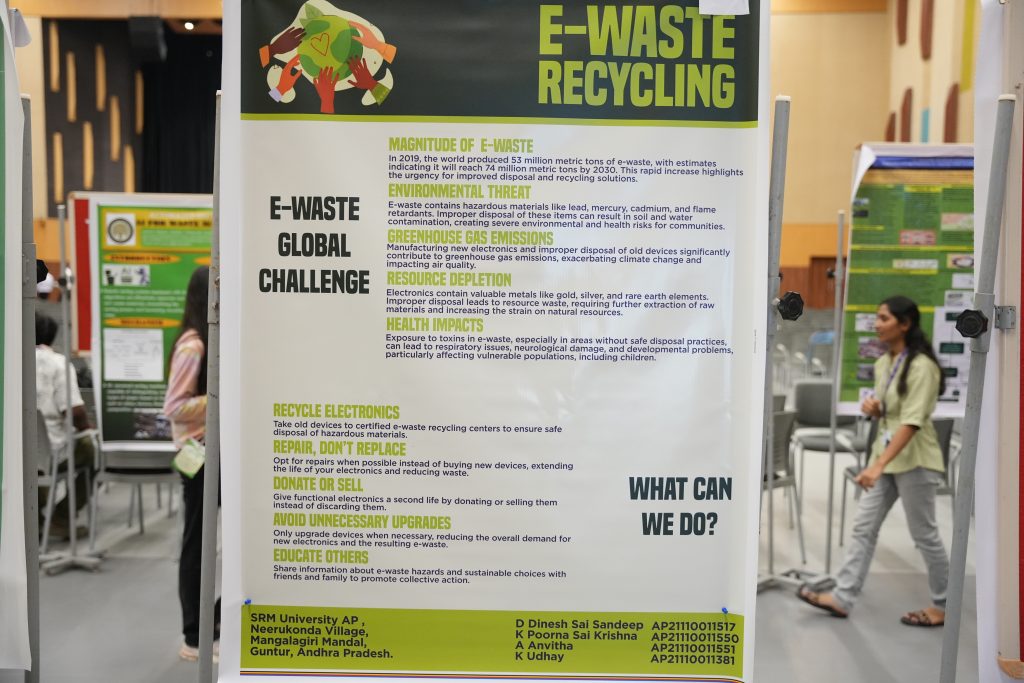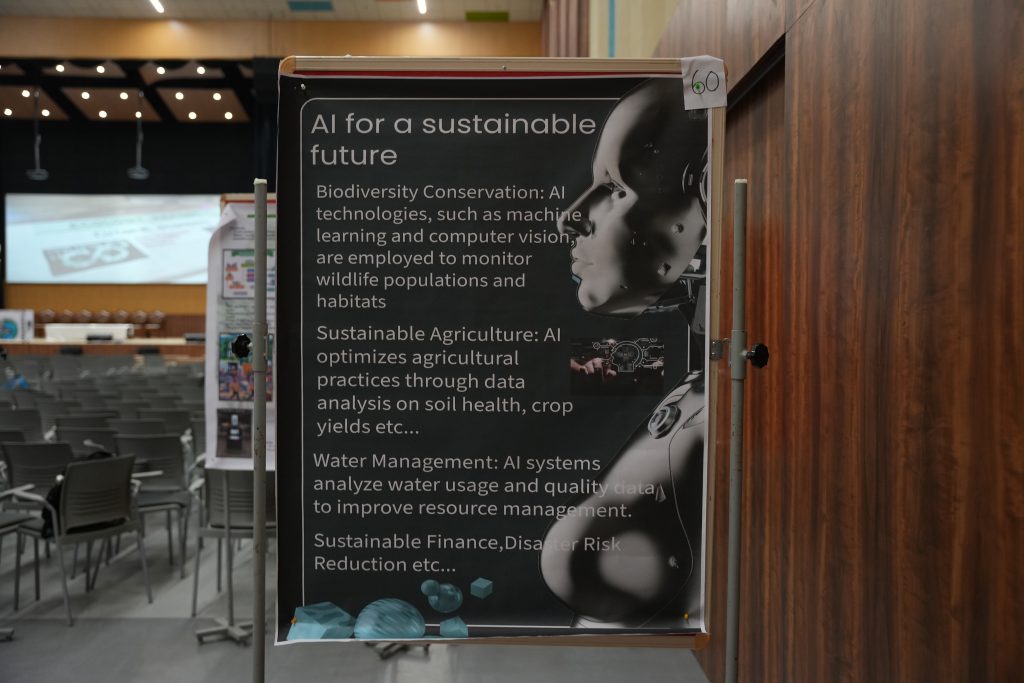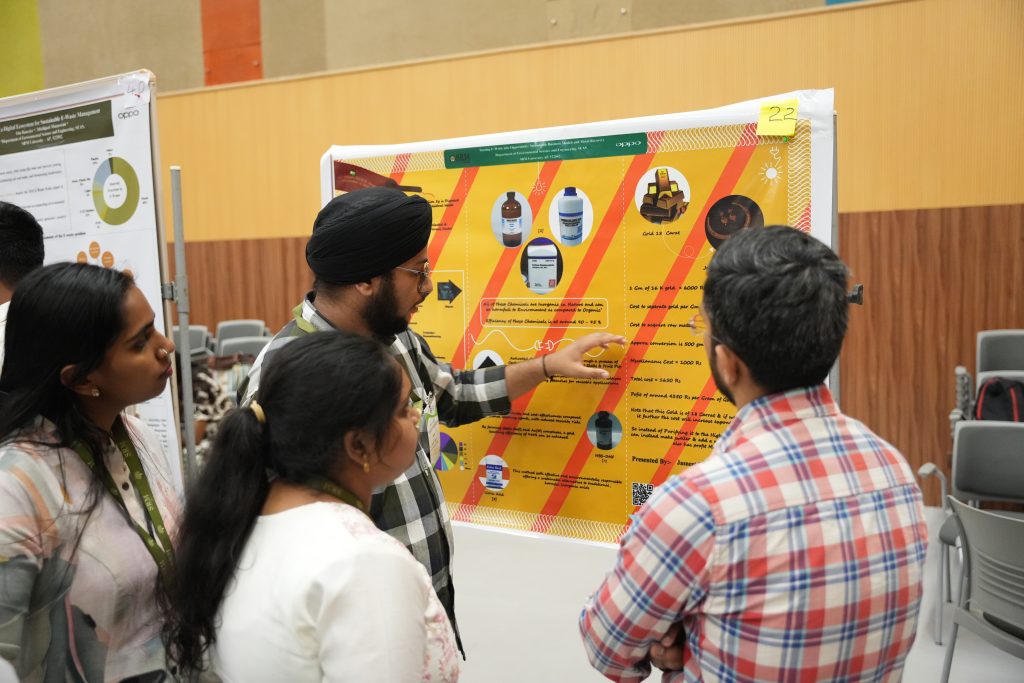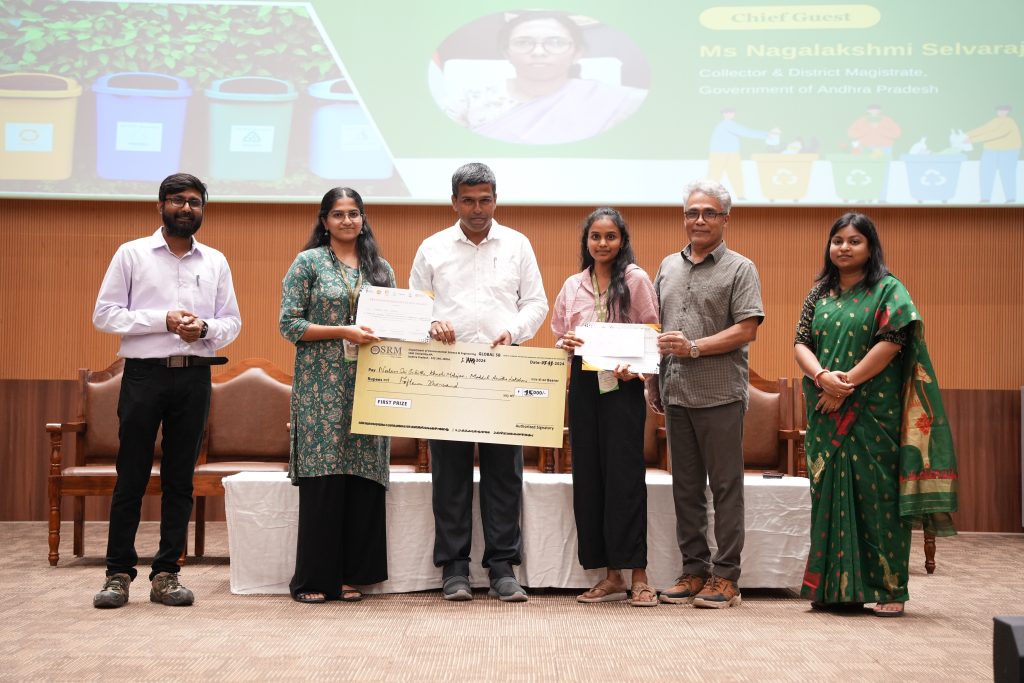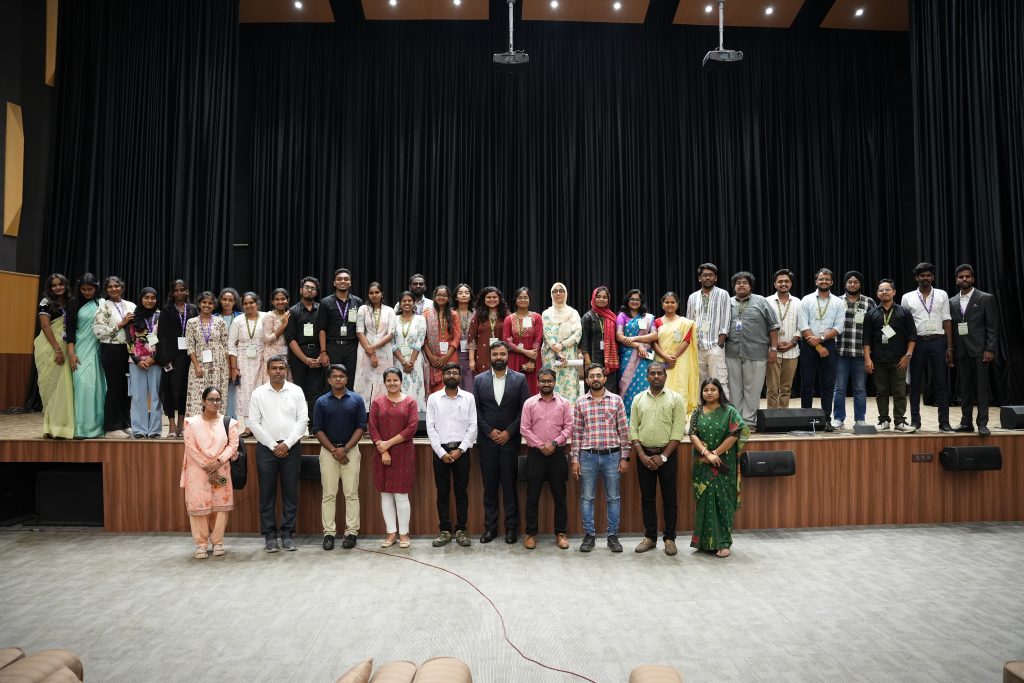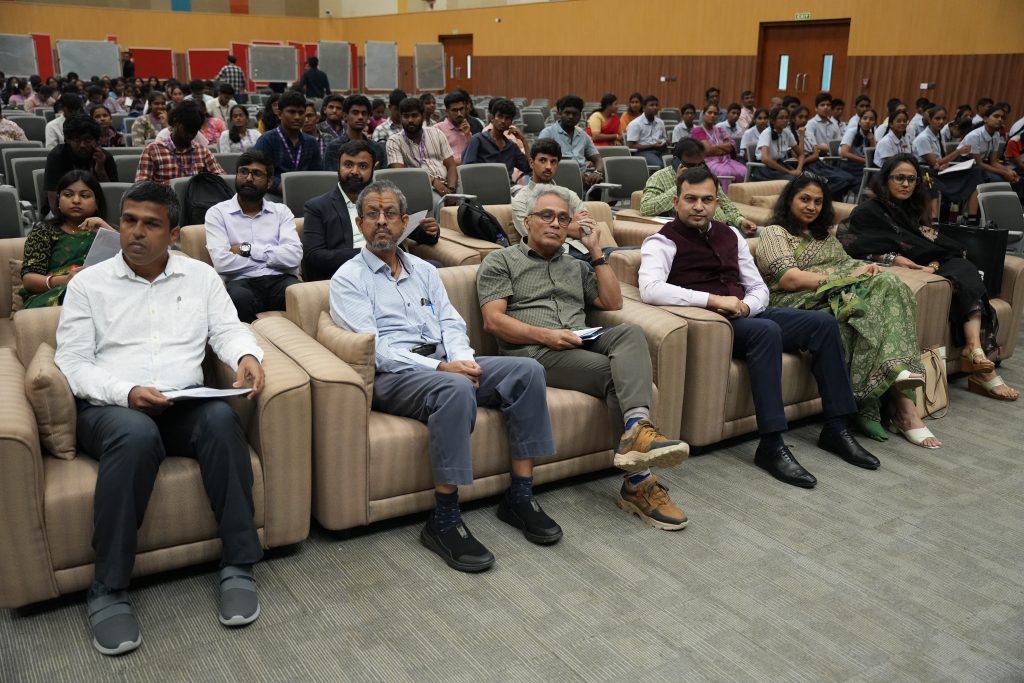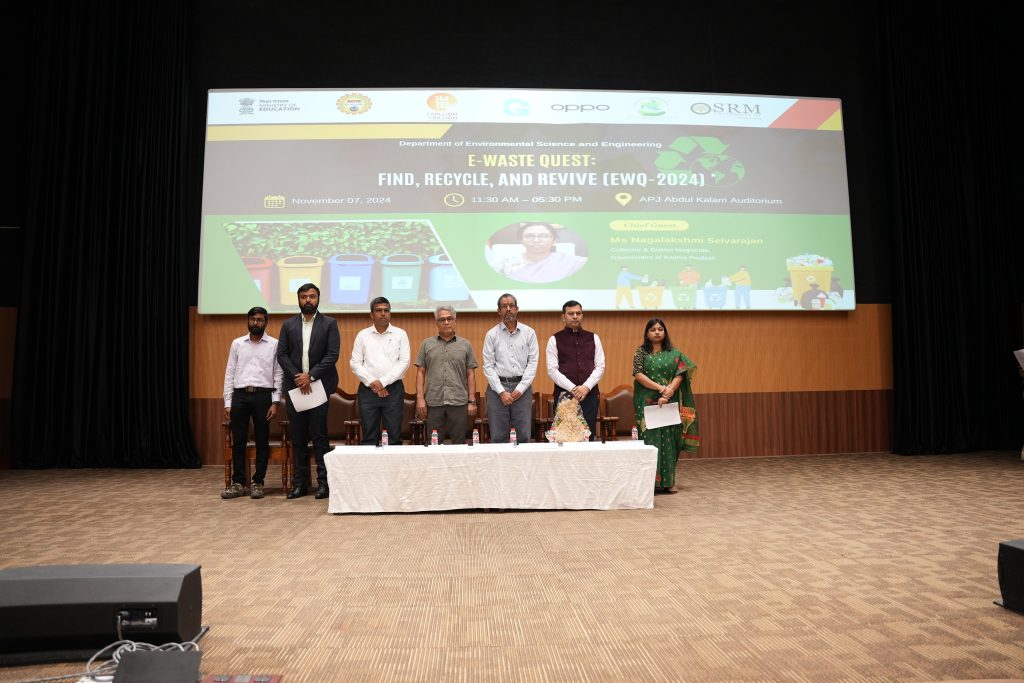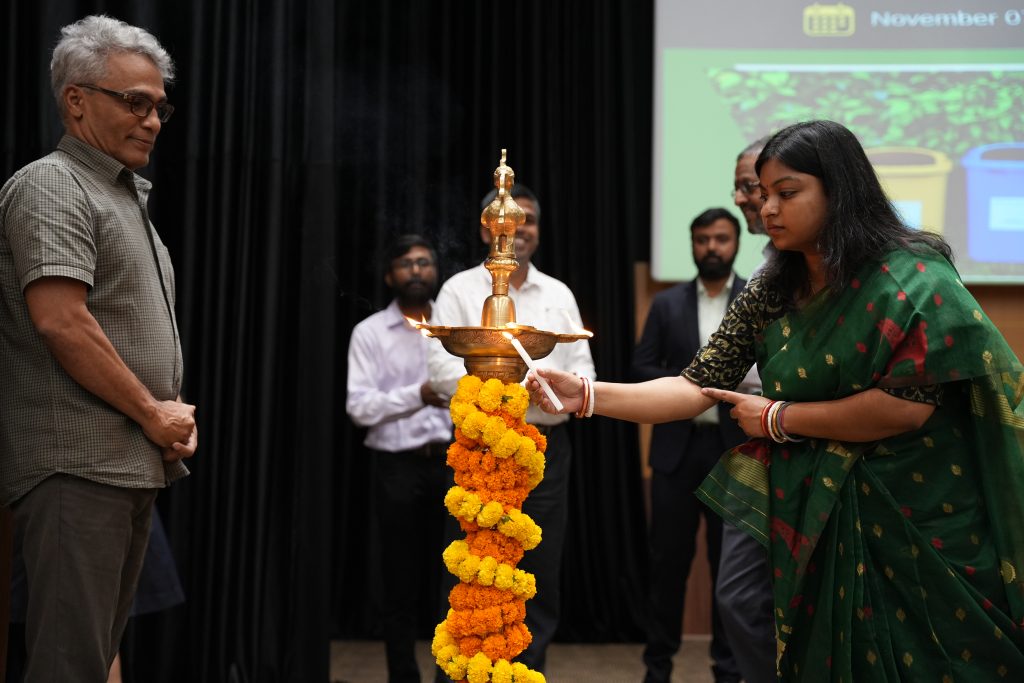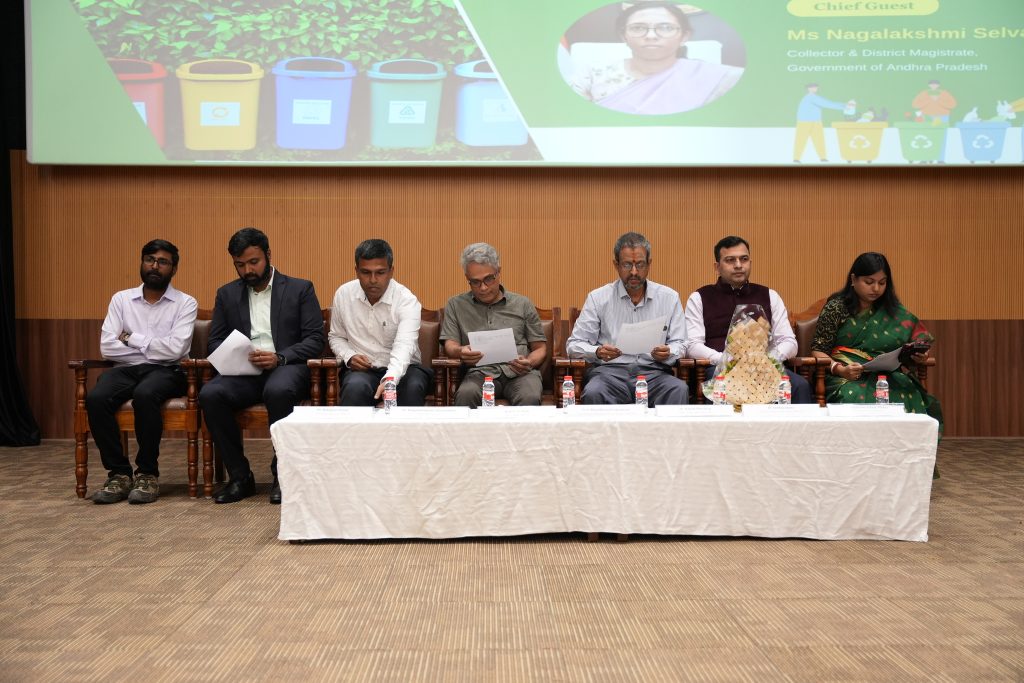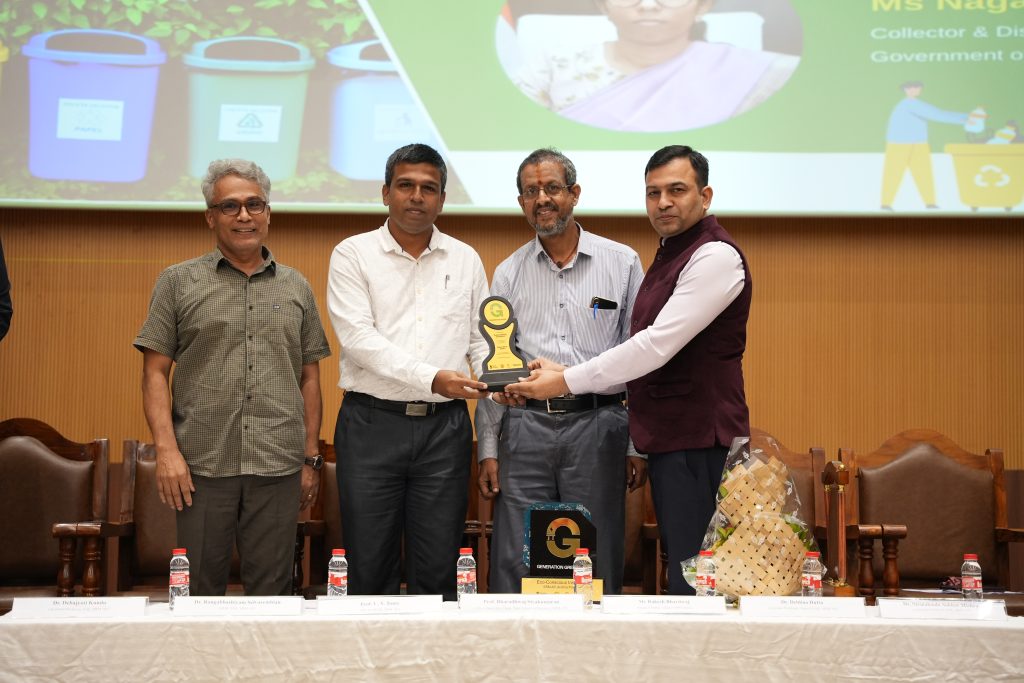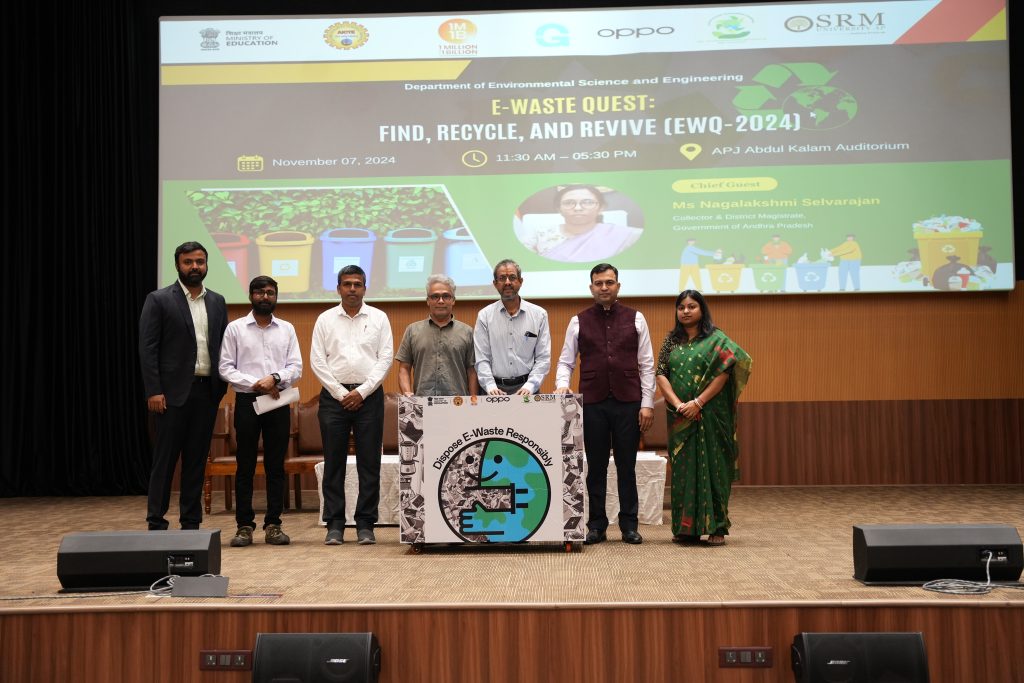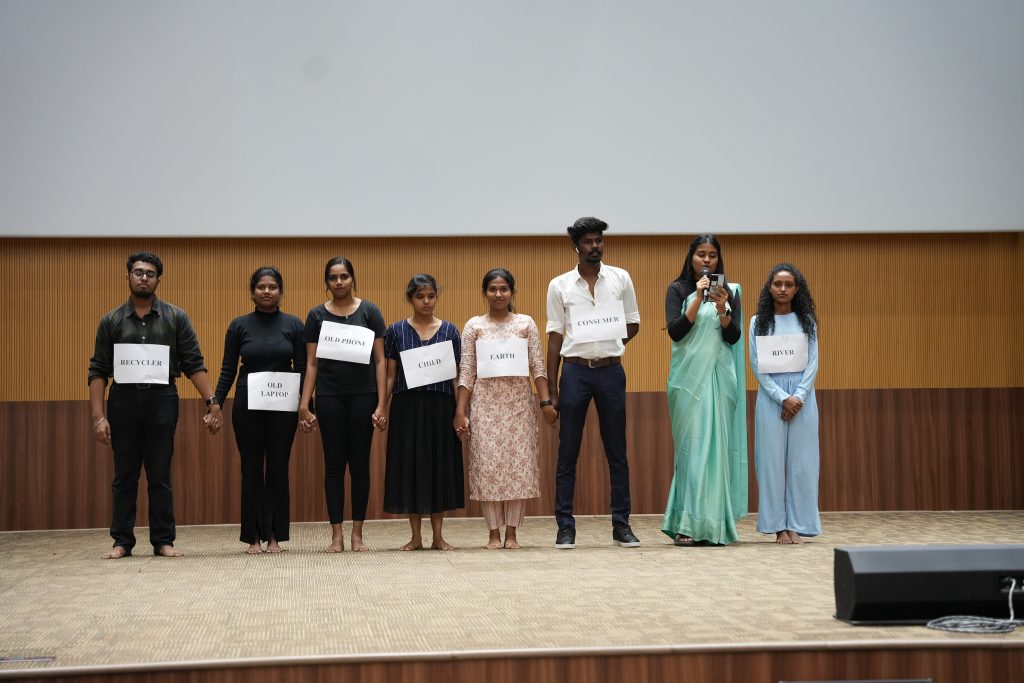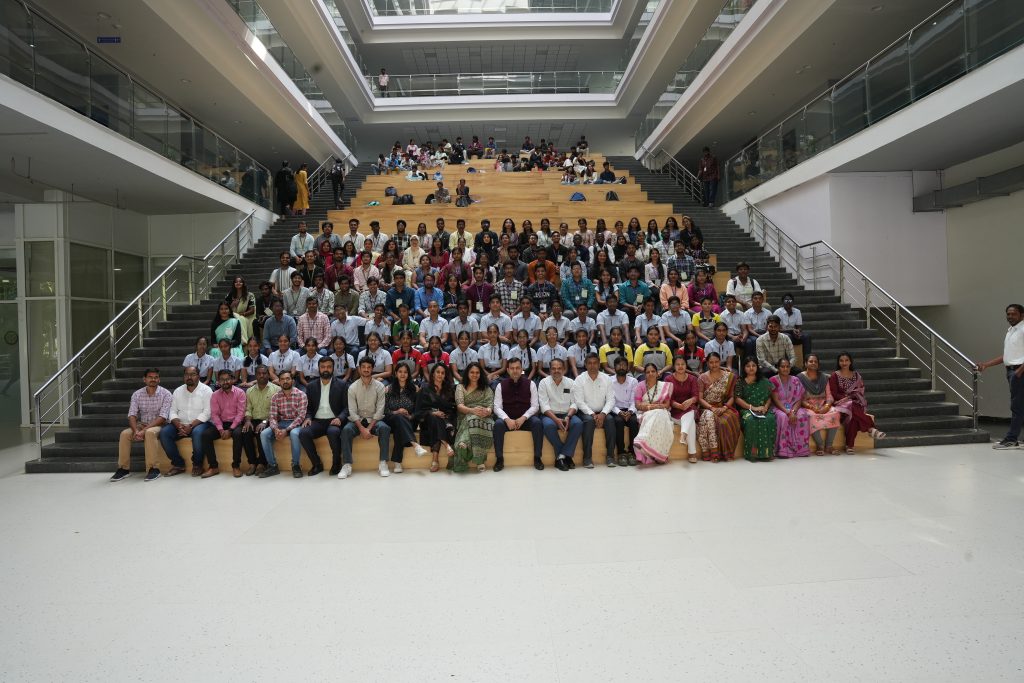“A New Dawn of Water Sustainability”: 1st Water Elixir Meet 2025
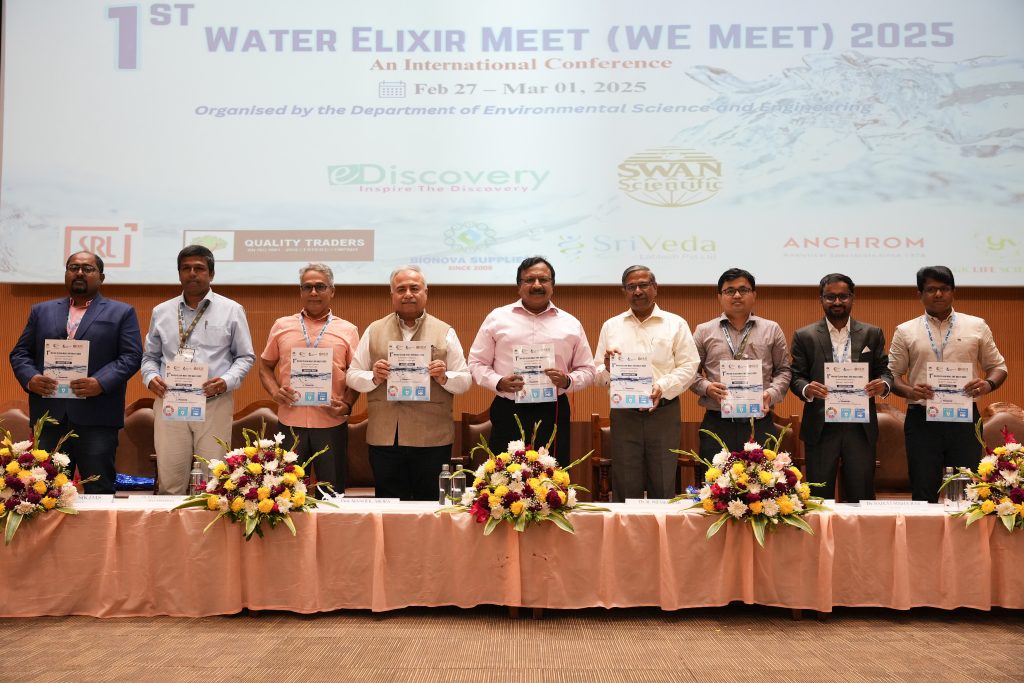
The Department of Environmental Science and Engineering hosted the 1st Water Elixir Meet (WE Meet 2025), a three-day international conference bringing together global minds to address one of the world’s most pressing challenges: water sustainability and security on Feb 27 – Mar 01, 2025. The conference was inaugurated by Prof. Rajasekhar Balasubramanian, Provost’s Chair Professor Group Head (Hydraulics, Hydrology and Climate Resilience), Department of Civil and Environmental Engineering, National University of Singapore.
“The available water quantity is decreasing, and the water quality is declining. There is a dire need to look into these parameters holistically and not separately. The We Meet 2025 is an ideal platform where scientists, researchers, policymakers, and industry leaders converge to address and manage global water resources efficiently and strategically,” stated Prof. Rajasekhar in his inaugural address.
WE Meet 2025 brought together more than 150 research abstracts and an esteemed lineup of global speakers, sharing groundbreaking insights into water resources, hydrogeology, and environmental sustainability. Prof. Kwang Ho-Choo from Kyunpook National University, South Korea, Prof. Shiao-Shing Chen from National Taipei University of Technology, Taiwan, Prof. Fulvia Chiampo from Politecnico di Torino, Italy, were some of the notable international speakers who delivered keynote sessions at the conference.
Prof. Manoj K Arora, Vice Chancellor, remarked beyond academic and research possibilities, WE Meet 2025 aimed at fostering global partnerships, innovative solutions, and cultural exchange. He stated, “WE Meet 2025 is a timely conference organised to address critical issues such as water resource management and water conservation.” Dr Rangabhashiyam Selvasembian, Head of the Department of Environmental Science and Engineering, also opined that this groundbreaking gathering fosters dialogue for impact. He said that the conference is a testament to the power of creative action in securing a sustainable tomorrow.
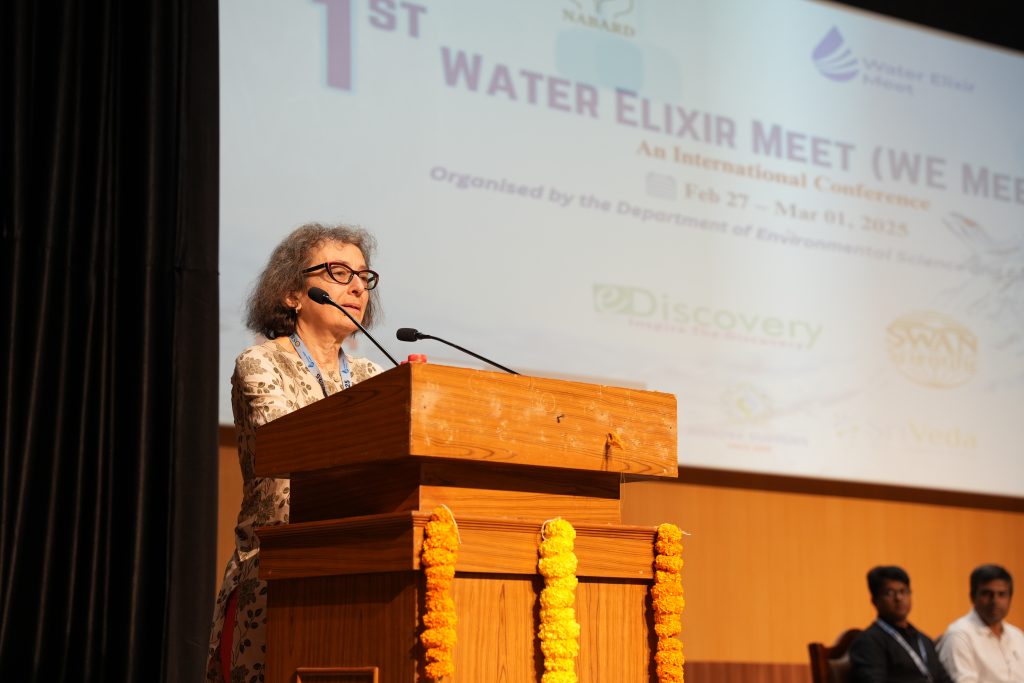
By showcasing cutting-edge technologies and driving policy advancements, WE Meet 2025 at SRM University-AP serves as a catalyst for real-world change. Exemplary research works such as the Best Oral Presentation and the Best Poster Presentation, were awarded top prizes at the valedictory ceremony. The conference also saw the participation of Registrar Dr R Premkunar, Dean – School of Engineering and Sciences, Prof. C V Tomy, Dean–Research, Prof. Ranjit Thapa, faculty, scholars and students of the varsity.
As the world grapples with increasing water challenges, this landmark international conference paves the way for a transformative journey to secure the future of water.
- Published in Departmental News, ENVS News, News, Research News
Dr Debajyoti’s Research on Improving Biofuel Production
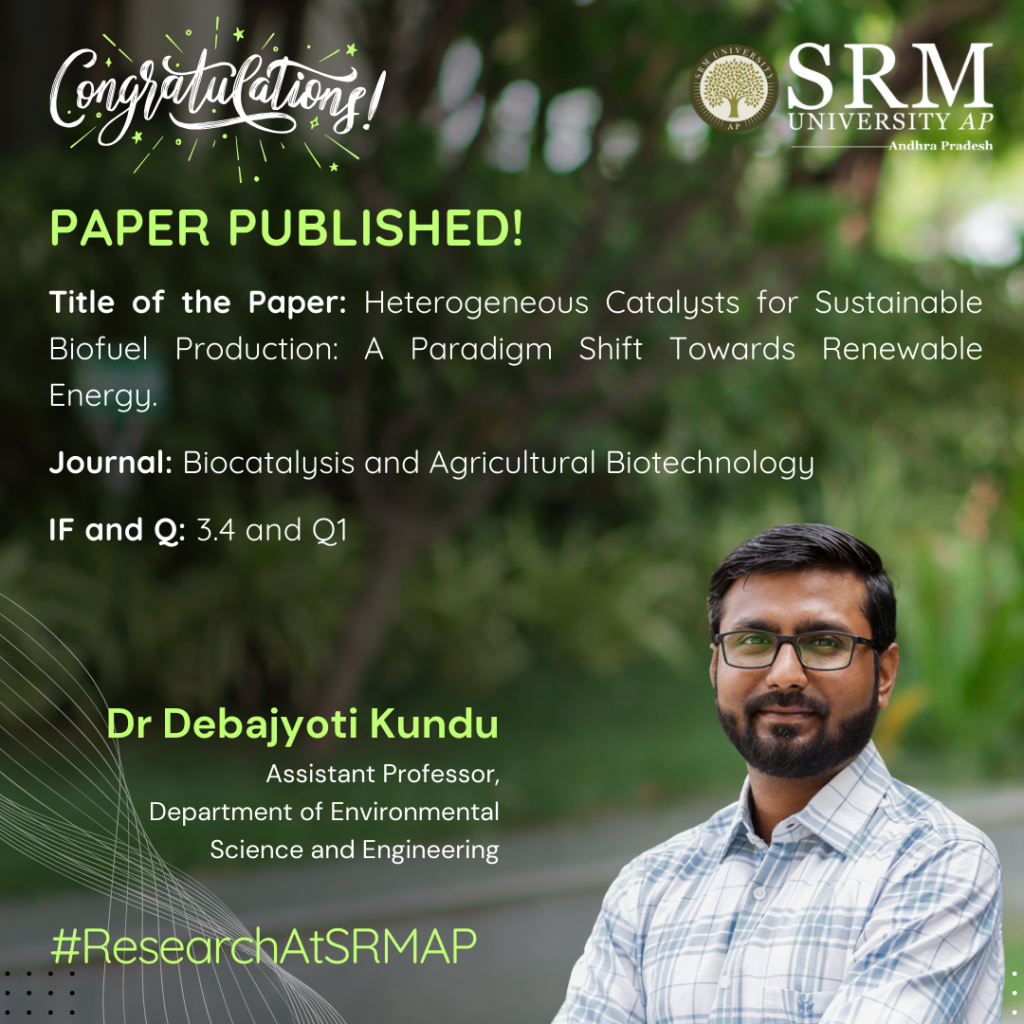 In the quest for sustainable energy solutions, Dr Debajyoti Kundu, from the Department of Environmental Science and Engineering, examines the potential of biofuels through his research paper – “Heterogeneous Catalysts for Sustainable Biofuel Production: A Paradigm Shift Towards Renewable Energy.” The paper highlights the importance of heterogeneous catalysts for improving biofuel production efficiency. The research also suggests future research to support sustainable energy practices.
In the quest for sustainable energy solutions, Dr Debajyoti Kundu, from the Department of Environmental Science and Engineering, examines the potential of biofuels through his research paper – “Heterogeneous Catalysts for Sustainable Biofuel Production: A Paradigm Shift Towards Renewable Energy.” The paper highlights the importance of heterogeneous catalysts for improving biofuel production efficiency. The research also suggests future research to support sustainable energy practices.
Brief Abstract:
This study focuses on the use of heterogeneous catalysts for sustainable biofuel production. With the growing concerns around fossil fuel depletion and environmental pollution, biofuels derived from biomass are emerging as promising alternatives. The article explores the significant role of heterogeneous catalysts in enhancing biofuel production by improving conversion efficiency, recyclability, and environmental impact. By analyzing various biomass sources, structural compositions, and the application of catalysts in bioethanol, biobutanol, biodiesel, biogas, and biohydrogen production, the study highlights recent advancements and provides recommendations for future research to drive sustainable energy solutions.
Explanation in layperson’s terms:
This research looks at how we can produce more environmentally friendly fuels from natural materials like plants and waste. Traditional fuels like oil and coal are harmful to the environment, so we are turning to biofuels made from biomass (such as plants) as a cleaner alternative. A key part of making biofuels efficiently is using special catalysts—materials that help speed up chemical reactions. The study examines how different catalysts are used to convert biomass into biofuels such as bioethanol, biodiesel, and biogas. The goal is to improve the processes, making biofuels more sustainable and accessible for the future.
Practical Implementation and Social Implications:
This research has significant implications for advancing renewable energy. The use of heterogeneous catalysts can make biofuel production more efficient and environmentally friendly, reducing reliance on fossil fuels and mitigating climate change. By optimizing biofuel production processes, we can develop cleaner energy solutions that are sustainable, carbon-neutral, and beneficial for the environment. This study also supports the ongoing shift towards renewable energy, ensuring that biofuels can contribute to reducing global energy crises and health risks associated with fossil fuel use.
Future Research Plans
Our future research will focus on the development and optimization of biocatalysts for the bioconversion of biomass into biofuels. We aim to enhance the efficiency and sustainability of biocatalytic processes, exploring new catalysts and reaction conditions that can improve the conversion of various biomass feedstocks into valuable biofuels. This research will contribute to advancing biofuel production technologies, with an emphasis on reducing environmental impact and improving the scalability of bioconversion processes for renewable energy solutions
- Published in Departmental News, ENVS News, News, Research News
Book Chapter on Wastewater Treatment and Energy Production
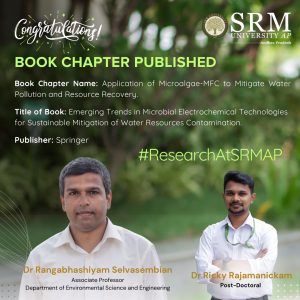 In an era where sustainable energy and environmental conservation are paramount, integration of Microalgae with Microbial Fuel Cells for Wastewater Treatment and Energy Generation emerges as a groundbreaking contribution to biotechnology. The book chapter, “Application of Microalgae-MFC to Mitigate Water Pollution and Resource Recovery” authored by Post-doctoral Research Scholar, Dr Ricky Rajamanickam under the guidance of Associate Professor and Head of the Department of Environmental Science and Engineering, Dr Rangabhashiyam Selvasembian explores the revolutionary potential of microalgae-driven microbial fuel cells (MFCs) in tackling wastewater pollution while generating renewable energy. This work—featured in the book titled, Emerging Trends in Microbial Electrochemical Technologies for Sustainable Mitigation of Water Resources Contamination brings together leading experts offering invaluable insights for scientists, engineers, and policymakers striving for a cleaner and greener future.
In an era where sustainable energy and environmental conservation are paramount, integration of Microalgae with Microbial Fuel Cells for Wastewater Treatment and Energy Generation emerges as a groundbreaking contribution to biotechnology. The book chapter, “Application of Microalgae-MFC to Mitigate Water Pollution and Resource Recovery” authored by Post-doctoral Research Scholar, Dr Ricky Rajamanickam under the guidance of Associate Professor and Head of the Department of Environmental Science and Engineering, Dr Rangabhashiyam Selvasembian explores the revolutionary potential of microalgae-driven microbial fuel cells (MFCs) in tackling wastewater pollution while generating renewable energy. This work—featured in the book titled, Emerging Trends in Microbial Electrochemical Technologies for Sustainable Mitigation of Water Resources Contamination brings together leading experts offering invaluable insights for scientists, engineers, and policymakers striving for a cleaner and greener future.
Brief Introduction to the Book Chapter
The chapter explores the integration of microalgae with microbial fuel cells (MFCs) for simultaneous wastewater treatment and energy generation. It delves into the mechanisms of microalgae-based MFCs, focusing on electricity generation, carbon capture, and the production of value-added bioproducts. The work highlights this technology’s potential for addressing water pollution and resource depletion while advancing sustainable energy solutions.
Significance of the Book Chapter
This chapter is significant as it addresses pressing global challenges such as water pollution, resource depletion, and the need for sustainable energy solutions. It aligns with the Sustainable Development Goals and contributes to advancing integrated biotechnological solutions for environmental and energy challenges.
Target Audience
The book chapter targets environmental scientists, engineers, policy makers, and researchers working in biotechnology, wastewater management, and renewable energy. It is also resourceful for students and professionals interested in sustainable development and innovative biotechnologies.
Co-Authors or Major Contributors
Dr Ricky – (First author) (Postdoc)
Dr Rangabhashiyam Selvasembian (Corresponding author) (Associate Professor)
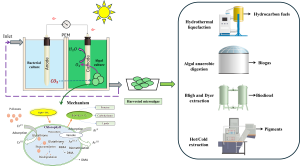
- Published in Departmental News, ENVS News, News, Research News
Interdisciplinary Research on Groundwater Fluoride Contamination
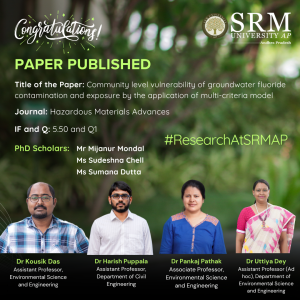 Assistant Professors – Dr Kousik Das, Dr Harish Puppala, Associate Professor- Dr Pankaj Pathak, Uttiya Dey, along with Research Scholars – Mr Mijanur Mondal, Ms Sudeshna Chell, Ms Sumana Dutta, and Ms Pankaj Kumar come up with an interdisciplinary research breakthrough in their paper, “Community-Level Vulnerability of Groundwater Fluoride Contamination and Exposure by the Application of Multi-Criteria Model.” The authors examine fluoride exposure in villages like Chintal Cheruvu, Rompicherla, Shantamangalur, Thimmapur, and Nadendla.
Assistant Professors – Dr Kousik Das, Dr Harish Puppala, Associate Professor- Dr Pankaj Pathak, Uttiya Dey, along with Research Scholars – Mr Mijanur Mondal, Ms Sudeshna Chell, Ms Sumana Dutta, and Ms Pankaj Kumar come up with an interdisciplinary research breakthrough in their paper, “Community-Level Vulnerability of Groundwater Fluoride Contamination and Exposure by the Application of Multi-Criteria Model.” The authors examine fluoride exposure in villages like Chintal Cheruvu, Rompicherla, Shantamangalur, Thimmapur, and Nadendla.
Abstract
Elevated fluoride (F⁻) levels in groundwater, primarily due to geogenic processes, pose significant health risks, including dental and skeletal fluorosis and neurological disorders. This study aimed to quantify source-dependent F⁻ exposure at the community level in selected tropical dry regions of Andhra Pradesh, India. These locations include Chintal Cheruvu, Rompicharala, Shantamangalur, Thimmapur, and Nadendla. Community surveys and drinking water sample analyses were conducted in these regions. Dental Fluorosis Index (DFI) used to estimate exposure levels across age and sex groups. Findings of surveys indicate that groundwater consumption with high F⁻ (4.3 mg/L) results in the highest exposure dose (0.62 mg/kg/day), with Chintal Cheruvu identified as the most affected. A strong positive correlation was observed between exposure dose, water F⁻ content, and the Community Fluorosis Index (CFI). Dental fluorosis prevalence exceeded 80% across all age groups, and household surveys revealed 100% unawareness of F⁻ exposure risks. The magnitude of FII for Chintal Cheruvu is 0.563 which is highest among the considered regions indicating that it is most impacted region that needs remedial measures first in the hierarchy. Rompicharala with FII as 0.252, Nadendla (0.223), Shantamangalur (0.214), and Thimmapur (0.188) follows the hierarchy.
Explanation in layperson’s terms.
The outcome of the study concludes that regionally most of the places of Andhra Pradesh is affected the by the groundwater fluoride contamination. People are getting affected by the consumption of high fluoridated water which is visible from the dental fluorosis. The area is having high groundwater fluoride is having highest severe dental fluorosis cases. Among the villages, Chintal Cheruvu had the highest fluoride level while Thimmapur had the lowest. Signs of dental fluorosis were most noticeable among younger individuals who are still developing. The exposure dose varied across villages, with Chintal Cheruvu having the highest exposure dose followed by Rompicharala. Other symptoms of fluorosis, such as skin allergies and body pain are also predominant. Most villages had alternative sources of drinking water, except for Chintal Cheruvu, where residents continued to use contaminated water due to a lack of alternatives. There is a clear link between lack of awareness about fluoride toxicity and higher exposure levels as apparent from the questionnaire survey.
Practical /Social Implications
The immediate action is necessary to reduce fluoride exposure, provide safe drinking water, and raise awareness about fluoride toxicity to meet sustainable development goals by 2030. The findings highlight the need for integrated approaches combining mitigation, education, and sustainable practices to tackle fluoride contamination and improve the overall well-being of affected communities.
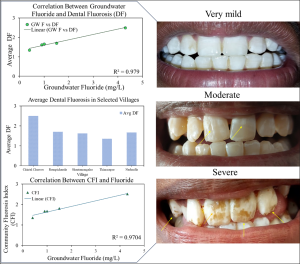
- Published in CIVIL NEWS, Departmental News, ENVS News, News, Research News
2D Metallene Designs to Advance Multifunctional Electrocatalysis
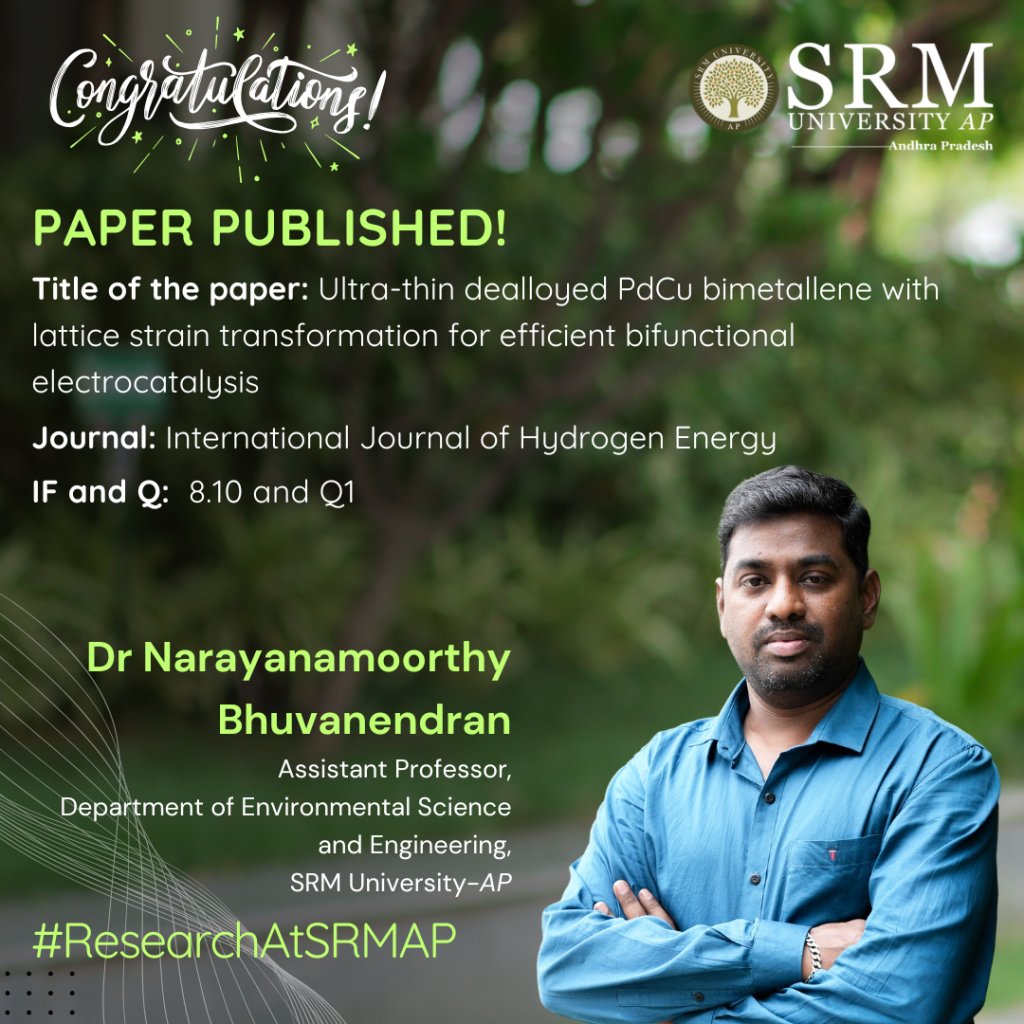
Dr Narayanamoorthy Bhuvanendran, Assistant Professor in the Department of Environmental Science and Engineering, has published his research work as an article titled “Ultra-thin Dealloyed PdCu Bimetallene with Lattice Strain Transformation for Efficient Bifunctional Electrocatalysis” in the esteemed International Journal of Hydrogen Energy, which has an impact factor of 8.10. His work underscores the development of 2D PdCu bimetallene with improved structural and electronic properties displaying super-catalytic behaviour.
Abstract
Two-dimensional (2D) PdCu bimetallene (PdCu) demonstrates exceptional structural and electronic properties, making it highly effective for electrochemical reactions in energy applications. Electrochemical dealloying (DA) of PdCu enhances surface reactivity by modulating electronic structure and inducing strain, optimising its performance for oxygen reduction (ORR) and methanol oxidation (MOR) in alkaline media. DA PdCu features a heterogeneous surface with abundant defects, improving active site availability and reaction kinetics. It achieves superior ORR mass activity (0.62 mA µg⁻¹) with a 10 mV positive half-wave potential shift after 20,000 cycles and MOR mass activity (3335.9 mA mg⁻¹) with 62.3% retention after 10,000 cycles. Theoretical studies reveal the impact of strain-induced electronic modulation on intermediate adsorption energies, corroborating experimental findings. This alloying-dealloying strategy in 2D PdCu bimetallene offers a robust approach to advancing multifunctional electrocatalysis with enhanced durability and performance.
Explanation of the Research in Layperson’s Terms
This research highlights the development of a two-dimensional PdCu bimetallene catalyst with tailored structural and electronic features, offering transformative advancements for electrochemical energy conversion and storage systems. The unique properties of 2D metallene layers, including their high surface area, tunable electronic structure, and enhanced surface reactivity, play a pivotal role in optimising catalytic performance. By employing a controlled dealloying process, the atomic and electronic structure of PdCu bimetallene is significantly modified, introducing lattice distortions, abundant surface defects, and a heterogeneous crystalline-amorphous interface. These features create more active sites and improve the interaction with reaction intermediates, leading to superior catalytic behaviour. The material demonstrates outstanding efficiency in oxygen reduction (ORR) and methanol oxidation (MOR), critical reactions in fuel cells and other electrochemical energy systems. For ORR, the catalyst achieves high mass activity, long-term stability, and resistance to degradation, maintaining its performance after extensive testing. In MOR, the catalyst exhibits exceptional activity and durability, retaining a significant portion of its efficiency over prolonged cycles. These structural and functional attributes emphasize the importance of 2D metallene designs and the alloying-dealloying strategy in enhancing the structure-activity relationship, establishing a foundation for innovative electrocatalysts in sustainable energy technologies.
Practical Implementation/ Social Implications of the Research
This research offers a practical pathway to revolutionise renewable energy systems by advancing next-generation electrocatalysts for fuel cells, metal-air batteries, and other energy conversion technologies. The optimised two-dimensional PdCu bimetallene, with enhanced ORR and MOR performance, demonstrates significant potential for clean energy applications such as proton-exchange membrane fuel cells and direct methanol fuel cells, addressing critical needs for efficiency and durability. The scalable, environmentally friendly alloying-dealloying synthesis reduces reliance on expensive platinum, lowering production costs while delivering high catalytic performance. By enabling efficient energy storage and conversion, supporting carbon-neutral systems, and inspiring the design of versatile 2D metallenes for diverse applications, this research significantly contributes to sustainable energy transitions and global climate goals.
Collaborations
- Prof. Sae Youn Lee, Department of Energy and Materials Engineering, Dongguk University, Seoul, Republic of Korea.
- Dr Wan-Gil Jung, Korea Basic Science Institute, Gwangju Center, Republic of Korea.
- Prof. Ming-Chang Lin, Department of Applied Chemistry, National Yang-Ming Chiao Tung University, Hsinchu, Taiwan.
- Dr Venkatesan Srinivasadesikan, Department of Chemistry, School of Science and Humanities, Vignan’s Foundation for Science, Technology and Research, Guntur, Andhra Pradesh, India.
Future Research Plan
Future research will focus on designing nanostructured hybrid electrocatalysts with enhanced activity, stability, and selectivity for energy and environmental applications. Emphasis will be placed on tailoring nanoscale architectures and synergistic material interactions to optimize performance in processes such as water splitting, CO2 reduction, NO3 reduction, fuel cells, and pollutant degradation, enabling scalable and sustainable solutions to global challenges.
- Published in Departmental News, ENVS News, News, Research News
Unveiling Microplastic Pollution in Landfill-Mined Bio-Earth
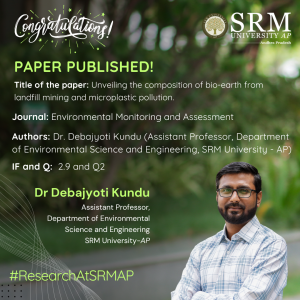 Dr Debajyoti Kundu, from the Department of Environmental Science and Engineering, has conducted pioneering research on the composition of bio-earth recovered from landfill mining at the Bhandewadi landfill in Nagpur, India. His study, Unveiling the Composition of Bio-Earth from Landfill Mining and Microplastic Pollution, reveals the presence of microplastics in bio-earth, raising concerns about its safety for agricultural use. The research underscores the importance of addressing microplastic contamination to ensure the sustainable application of landfill-mined materials in agriculture.
Dr Debajyoti Kundu, from the Department of Environmental Science and Engineering, has conducted pioneering research on the composition of bio-earth recovered from landfill mining at the Bhandewadi landfill in Nagpur, India. His study, Unveiling the Composition of Bio-Earth from Landfill Mining and Microplastic Pollution, reveals the presence of microplastics in bio-earth, raising concerns about its safety for agricultural use. The research underscores the importance of addressing microplastic contamination to ensure the sustainable application of landfill-mined materials in agriculture.
A Brief Abstract:
This study explores the composition of bio-earth derived from landfill mining at the Bhandewadi landfill, Nagpur, India, and investigates the presence of microplastics within it. The bio-earth was characterized by key parameters such as moisture content, organic carbon, nutrient levels, and heavy metal concentrations. Microplastic contamination was also assessed using ATR-FTIR spectroscopy, revealing a significant presence of microplastics in the bio-earth. The findings highlight the need for further research and strategies to mitigate microplastic pollution to ensure the safe use of bio-earth in agricultural applications.
Explanation in layperson’s terms:
In this study, we looked at bio-earth, which is a material recovered from old landfill sites, and examined its quality and the presence of harmful microplastics. Landfill mining is an emerging technique that helps recover valuable resources from old waste. Bio-earth is often used as a natural fertilizer, but the problem is that it can contain tiny plastic particles (microplastics) which can harm the environment. Our research found that the bio-earth from a landfill in Nagpur, India, had both useful nutrients for plants and significant levels of microplastics. This is concerning because it could affect the safety of using such material in farming or gardening. Our work suggests that more research is needed to figure out how to remove these plastics and make the bio-earth safer for agricultural use.
Practical Implementation:
The findings of this research have significant implications for environmental management and waste recycling. The presence of microplastics in bio-earth poses risks to soil health, plant growth, and potentially to human health when used in agriculture. The research highlights the need for proper waste management techniques to reduce microplastic contamination and improve the safety of recycled materials like bio-earth. This study also calls for developing strategies to remove or reduce microplastics from landfill mining processes, ensuring that bio-earth can be used safely as a fertilizer or soil conditioner without further environmental harm.
Collaborations:
This research was conducted through collaboration between several esteemed institutions:
CSIR – National Environmental Engineering Research Institute (CSIR-NEERI), Nagpur, India
Banaras Hindu University (BHU), Varanasi, India
Future Research Plans:
We plan to develop methods for removing microplastics from bio-earth, assess their impact on soil and plant health, and explore sustainable waste processing techniques to reduce plastic contamination. Our goal is to enhance the safety and sustainability of landfill-mined materials in agriculture.
The link to the article:
https://link.springer.com/article/10.1007/s10661-024-13229-2
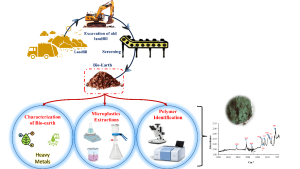
- Published in Departmental News, ENVS News, News, Research News
Dr Rangabhasiyam on Tackling the Issue of Microplastic Pollution
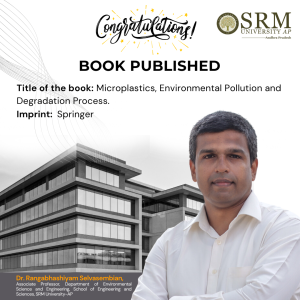 Microplastic pollution is an urgent environmental crisis that threatens ecosystems on land and in water. Addressing this critical issue, Associate Professor and HoD, Dr Rangabhashiyam Selvasembian from the Department of Environmental Science and Engineering has published a groundbreaking book titled Microplastics, Environmental Pollution and Degradation Process with Springer. This book examines the perilous effects of microplastics, their characterisation, and innovative treatment strategies. By integrating the latest research and insights, Dr Selvasembiyan’s work serves as a vital guide for students, researchers, and policymakers committed to combating microplastics and protecting our environment.
Microplastic pollution is an urgent environmental crisis that threatens ecosystems on land and in water. Addressing this critical issue, Associate Professor and HoD, Dr Rangabhashiyam Selvasembian from the Department of Environmental Science and Engineering has published a groundbreaking book titled Microplastics, Environmental Pollution and Degradation Process with Springer. This book examines the perilous effects of microplastics, their characterisation, and innovative treatment strategies. By integrating the latest research and insights, Dr Selvasembiyan’s work serves as a vital guide for students, researchers, and policymakers committed to combating microplastics and protecting our environment.
About this Book
This book presents microplastics pollution in land and water bodies, their hazardous effects, characterization approaches, and suitable means of utilizing advanced treatment options to solve the problem. It is mainly understood that microplastic pollutants are associated with water bodies, however there also exists soil contamination and their interaction with the food web. The discussions related to strategies and policies for the management of microplastics are very limited. This book not only narrows microplastic pollution in marine or fresh water bodies, but also takes into account the terrestrial environment, including the toxicity effects, characterization aspects and treatment approaches. The main feature of the book includes latest research related to microplastics pollution, examining the different health effects including environmental (related) issues and highlights the advances in treatment approaches. The book serves as a guide with an up-to-date information on microplastics related problems useful for students, researchers, professionals/environmentalists and also as a reference for policy makers.
Collaborations:
- Professor Ajay Kumar Mishra, Professor – Durban University of Technology, South Africa.
- Dr. Pankaj Raizada, Professor -School of Advanced Chemical Sciences, Shoolini University, Solan (H.P) India.
- Dr Elsayed T Helmy, Researcher – National Institute of Oceanography and Fisheries, Egypt
- Prof. Santhiagu Arockiasamy Professor- National Institute of Technology Calicut, India.
Link to the article: https://doi.org/10.1007/978-981-97-6461-7
- Published in Departmental News, ENVS News, News, Research News
SRM AP Joins OPPO India in its Clarion Call against E-Waste
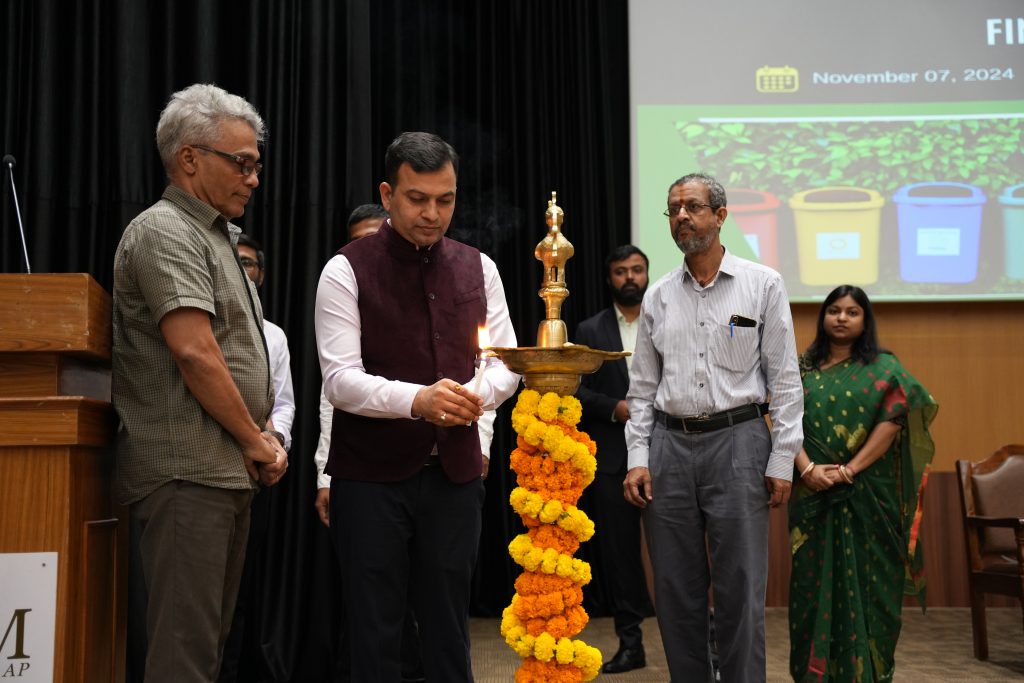 SRM University-AP, in collaboration with OPPO India and the All-India Council for Technical Education (AICTE), is partnering to support “Generation Green”—a national-level initiative aimed at empowering youth to become advocates of sustainability through green skills and actionable commitments. The first phase of the campaign saw AICTE and OPPO India partner with 1M1B to promote sustainable practices among youth by offering green internships to students across India. Launched on July 08, 2024, by AICTE Chairman Prof. T G Sitharam, in the presence of Dr Buddha Chandrasekhar, CCO, AICTE, over 9,000 students from more than 1,400 institutions applied to join the noble venture.
SRM University-AP, in collaboration with OPPO India and the All-India Council for Technical Education (AICTE), is partnering to support “Generation Green”—a national-level initiative aimed at empowering youth to become advocates of sustainability through green skills and actionable commitments. The first phase of the campaign saw AICTE and OPPO India partner with 1M1B to promote sustainable practices among youth by offering green internships to students across India. Launched on July 08, 2024, by AICTE Chairman Prof. T G Sitharam, in the presence of Dr Buddha Chandrasekhar, CCO, AICTE, over 9,000 students from more than 1,400 institutions applied to join the noble venture.
The second phase of the ‘Generation Green’ campaign witnessed SRM AP’s partnership with OPPO and AICTE for educating youngsters about the need for responsible electronic waste management. In alignment with this initiative, the varsity conducted E-Waste Quest 2024, wherein it enlightened students on the issue of waste management of discarded electronic items such as mobile phones, chargers, batteries, and wires. With over 400,000 pledges to date, the campaign now targets one million youth engagements by the end of 2024 to create a lasting impact on e-waste management and environmental preservation. On the occasion OPPO India awarded the SRM University with the title of Eco-Conscious Institution, reflecting the varsity’s commitment to sustainability.
Pro-Chancellor Dr P Sathyanarayanan and Vice Chancellor Prof. Manoj K Arora congratulated the Department of Environmental Science and Engineering for their dedication and commitment to this cause, while Prof. Bharadhwaj Sivakumaran, Dean-Paari School of Business and the officiating Vice Chancellor, emphasised, “Initiatives like the Generation Green Campaign illustrate how small, purposeful actions can catalyse significant change toward a sustainable future.”
Prof. C V Tomy, Dean of the School of Engineering and Sciences, addressed the gathering with an inspiring call to action, stating that every school must have an e-waste collection centre. He stated, “This effort not only promotes responsible disposal but also opens doors to entrepreneurial opportunities, instilling a mindset of sustainability and innovation among students.”
During the launch of the E-Waste Quest 2024, Mr Rakesh Bhardwaj from OPPO India stated, “Today marks a pivotal moment in our collective commitment to a sustainable future. This initiative encourages our youth to take ownership of their role in environmental stewardship.” Dr Rangabhashiyam Selvasembian, Associate Professor and Head-Department of Environmental Science and Engineering, stated, “A motivated and informed generation has the power to reshape our planet. If we do not take responsibility for its protection, no one else will.”
Dr Vinayak Kalluri, Dean-Academic Affairs, implored the youth to fight together in this crusade to save Mother Nature from the horrors of e-waste, noting, “The transition for a sustainable future arises from engaging in small acts of sustainability that result in big transformations.” Additionally, Collector and District Magistrate, Ms Nagalakshmi Selvarajan shared a meaningful message on the importance of community involvement. The E-Waste Quest 2024 served as a powerful reminder that collective efforts help shape a greener future where progress and sustainability go hand in hand.
- Published in Departmental News, ENVS News, News
Understanding the Impact of Sundarbans Mangroves on Global Oceanic Carbon Budgets
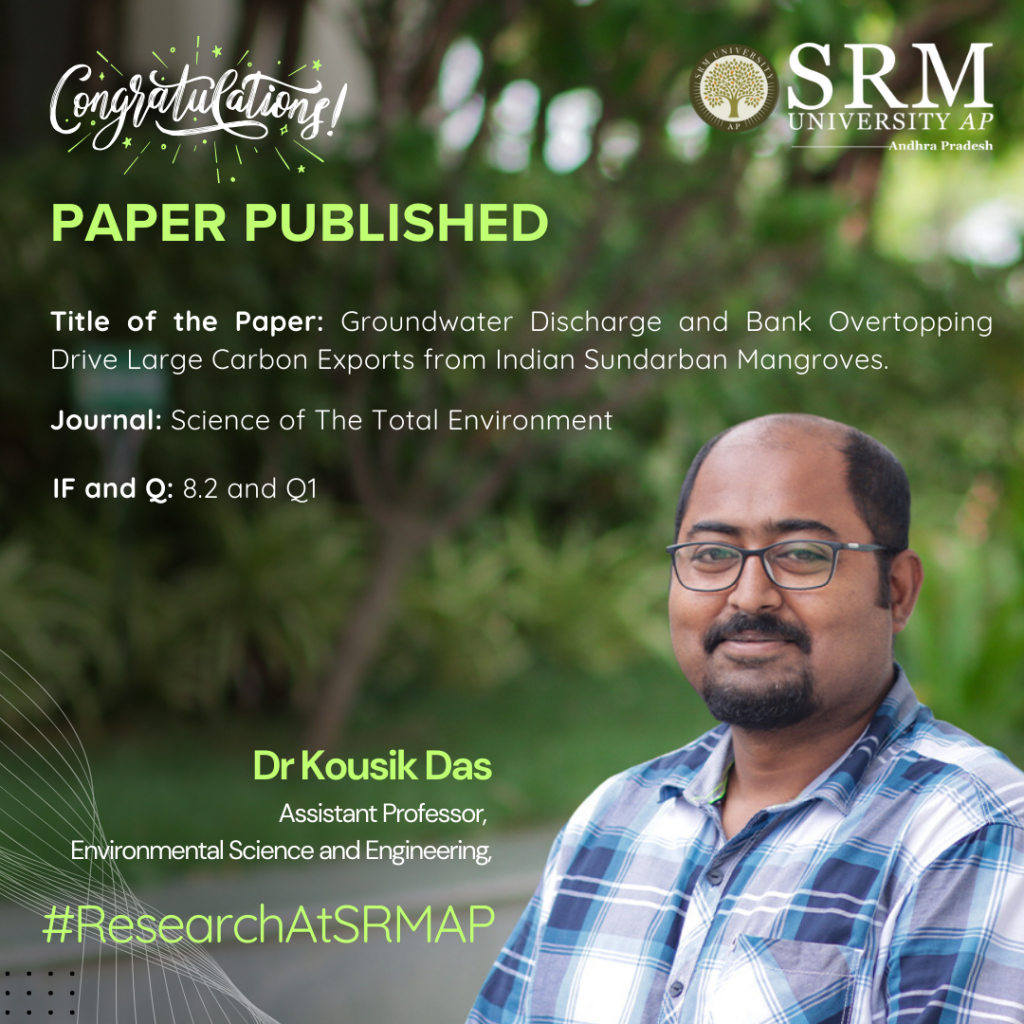
The Sundarbans represent the largest mangrove system on Earth, covering >10,000 km2. These mangroves can export a vast amount of aquatic carbon that can be potentially sequestered for millennia. Dr Kousik Das, Assistant Professor at the Department of Environmental Science and Engineering, collaborates with Southern Cross University, Australia and IIT Kharagpur to conduct breakthrough research to analyse and estimate the carbon flux between the Sunderbans and the Bay of Bengal. He has published a research paper titled “Groundwater discharge and bank overtopping drive large carbon exports from Indian Sundarban mangroves” in the Q1 journal Science of The Total Environment, having an impact factor of 8.2.
Abstract
We estimate porewater-driven carbon exchange between the Sundarbans and the Bay of Bengal using high-resolution time series and a radon groundwater mass balance approach spanning a neap-spring tidal cycle. Submarine groundwater discharge (SGD) increased from neap to spring tides by 352 % up to a maximum of 65.6 cm d−1 largely driven by creek bank overtopping after the mid-tide. Exports of dissolved organic and inorganic carbon and alkalinity doubled between neap and spring, likely due to the ‘first flush’ of older porewater in the mangrove flats. Groundwater discharge was a significant driver of the net carbon export, contributing up to 86.7 % of DIC and 74.0 % of alkalinity during the spring tide while contributing a lower proportion of DOC (4 %–23 %). If these results are representative of the Sundarbans more broadly, carbon fluxes from the Sundarbans would be more than an order of magnitude higher than some of the world’s largest rivers on an areal basis, highlighting the importance of Sundarbans mangroves to global oceanic carbon budgets.
Practical Implementation/Social Implications of the Research
This study shows the global importance of the Sundarbans mangrove system, with significant dissolved inorganic carbon and total alkalinity fluxes to the Bay of Bengal. It also shows that mangrove SGD is an important driver of dissolved inorganic carbon, dissolved inorganic carbon (DIC) and total alkalinity (TAlk) exports and that bank overtopping during mid and spring tides drives a ‘first flush’ of carbon from groundwater. When carbon fluxes from the study site were upscaled to the entire inundated area of the Sundarbans, DIC and TAlk exports were smaller than some of the world’s largest rivers, however when adjusted to the catchment size (assuming the Sundarbans mangrove catchment area is the extent of the mangroves; 10,200 km2), the areal carbon fluxes from the mangroves are more than an order of magnitude higher than these river systems
Dr Das aims to continue his research and further explore the large flux of carbon export due to tropical cyclones from the Indian Sundarbans to the Bay of Bengal.
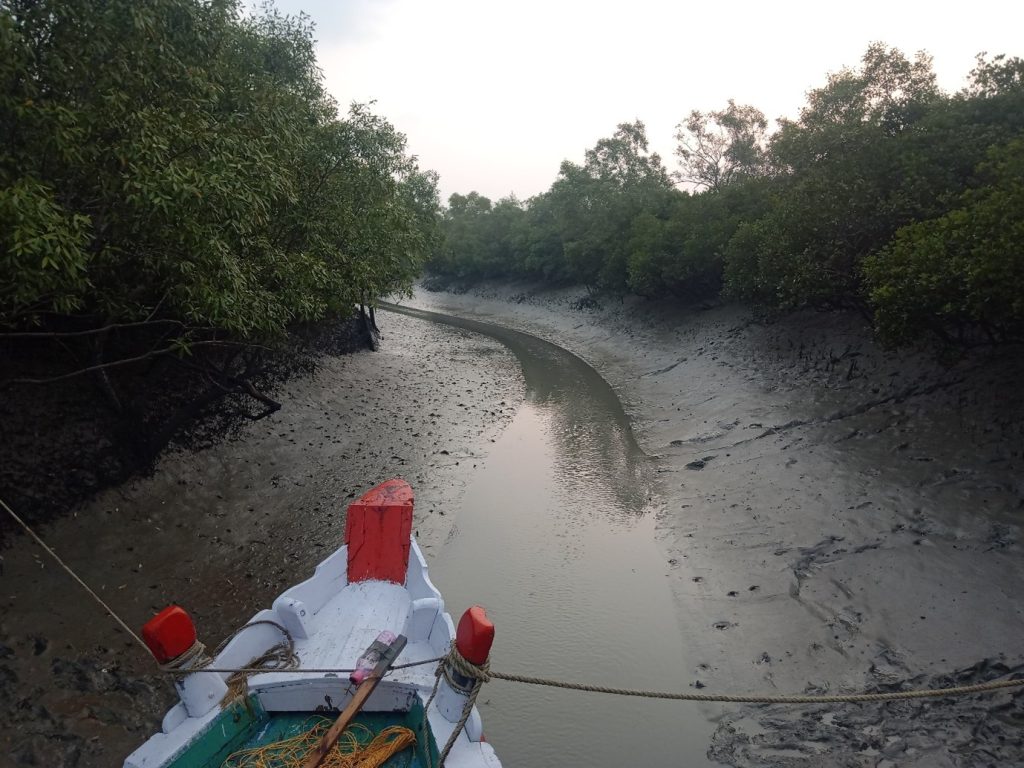
- Published in Departmental News, ENVS News, News, Research News
Dr Narayanamoorthy’s Review on Pt-based Electrocatalysts Features in Elsevier Journal of IF 20.8
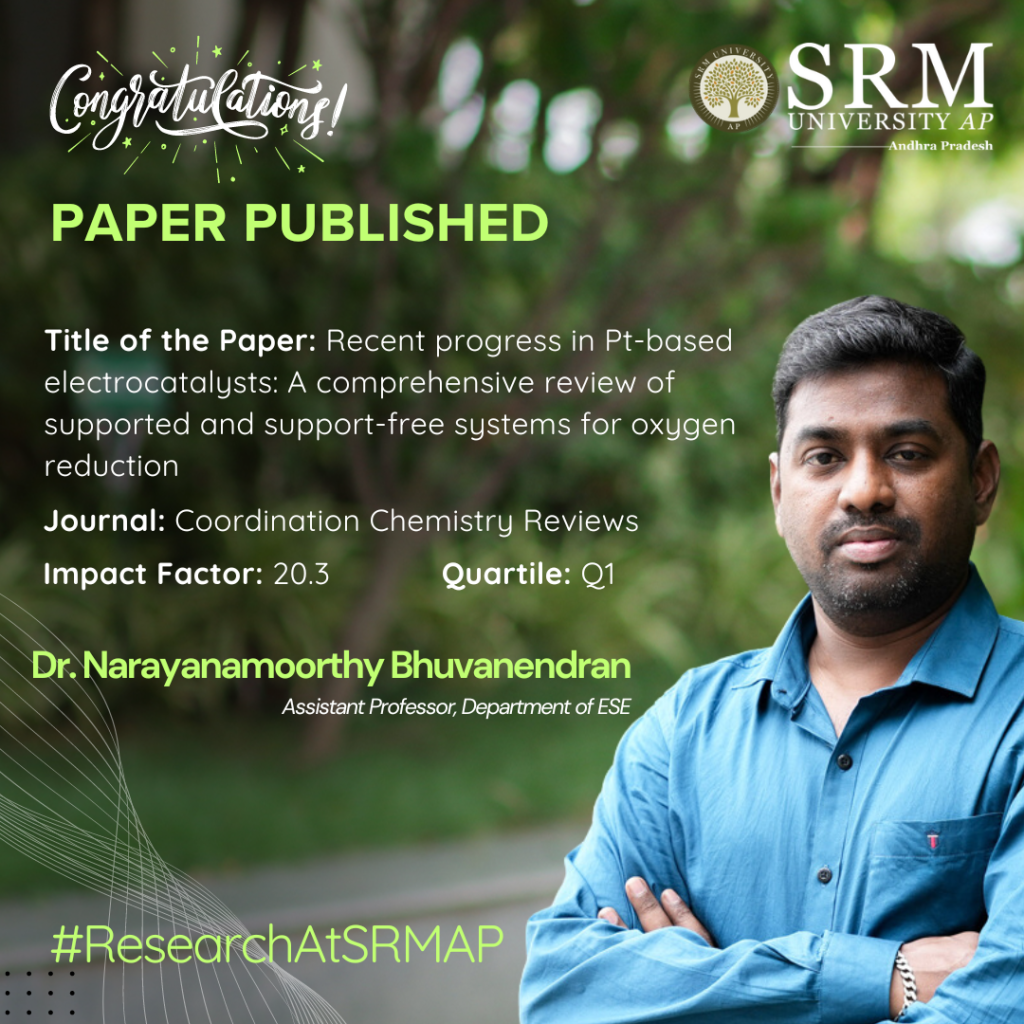
With the rising frequency of climate crises and to address growing energy demands and environmental concerns, a shift from conventional fossil fuels to sustainable alternatives is essential. As Hydrogen fuel cells are a viable and sustainable alternative to conventional fossil fuels, various research is being conducted in maximising the efficiency of fuel cells.
Dr Narayanamoorthy Bhuvanendran, Assistant Professor from the Department of Environmental Science and Engineering, works extensively in this field and has recently reviewed the advancements in Pt-based electrocatalysts that can reduce the Oxygen reduction rate (ORR) in Hydrogen fuel cells in his research paper. The paper titled “Recent progress in Pt-based electrocatalysts: A comprehensive review of supported and support-free systems for oxygen reduction” was published in the Q1 journal Coordination Chemistry Reviews with an impact factor of 20.8.
Abstract
Recent advancements in Pt-based catalysts for the oxygen reduction reaction (ORR) have improved energy conversion efficiency in fuel cells and metal-air batteries. However, balancing electrocatalyst activity and stability remains challenging. Due to Pt’s high cost and limited availability, research focuses on Pt alloys, hybrid catalysts, and nanostructured materials to enhance catalytic performance using cost-effective methods. Hybridising Pt with other active components offers synergistic effects and aligns with the U.S. Department of Energy’s 2025 targets. This review examines recent developments in supported and support-free Pt-based electrocatalysts, highlighting carbon, inorganic, and hybrid support materials, as well as support-free metal nanostructures, for superior ORR performance in energy applications.
Explanation of the Research in Layperson’s Terms
Hydrogen, with its abundance and eco-friendly properties, is a promising fuel for sustainable energy systems, powering vehicles like electric cars and buses through efficient energy conversion devices such as fuel cells. While fuel cells effectively convert hydrogen into electricity, further advancements in electrocatalysts and cost-efficiency are needed to make this technology commercially viable. The oxygen reduction reaction (ORR) in fuel cell cathodes requires efficient catalysts for better performance. Pt is the top ORR catalyst for low-temperature fuel cells due to its ability to break O-O bonds efficiently. However, issues like Pt nanoparticle dissolution, surface impurities, and structural changes during reactions limit its effectiveness. This review explores improving electrocatalysts by increasing active sites, boosting metal-support interaction, and enhancing stability for better performance.
Practical Implementation/ Social Implications of the Research
Several challenges remain in scaling Pt-based electrocatalysts for oxygen reduction reaction (ORR), particularly around cost, performance, and environmental impact. Platinum’s high cost and scarcity drive up production costs, and synthesis methods are complex and hard to scale. Catalyst durability also degrades over time in industrial conditions. Efforts are focused on developing green synthesis methods, recovering platinum from used catalysts, and exploring alternatives like atomic layer deposition to reduce Pt usage while enhancing efficiency. New nanostructures, such as 2D layers and hybrid materials, could balance performance and cost. Future research aims to meet the U.S. Department of Energy’s 2025 targets for improved performance and durability, essential for advancing Pt-based electrocatalysts and enabling widespread fuel cell adoption.
Collaborations
- Prof. Huaneng Su, Institute for Energy Research, Jiangsu University, Zhenjiang, China
- Prof. Sae Youn Lee, Department of Energy and Materials Engineering, Dongguk University, Seoul, Republic of Korea
- Dr Srinivasan Arthanari, Research Professor, Chungnam National University (CNU), Daejeon, Korea
- Dr Sabariswaran Kandasamy, Assistant Professor, Department of Biotechnology, PSGR Krishnammal College for Women, Coimbatore, India
Dr Narayanamoorthy will continue to work in this domain, developing novel nanostructured hybrid electrocatalysts for energy and environmental applications.
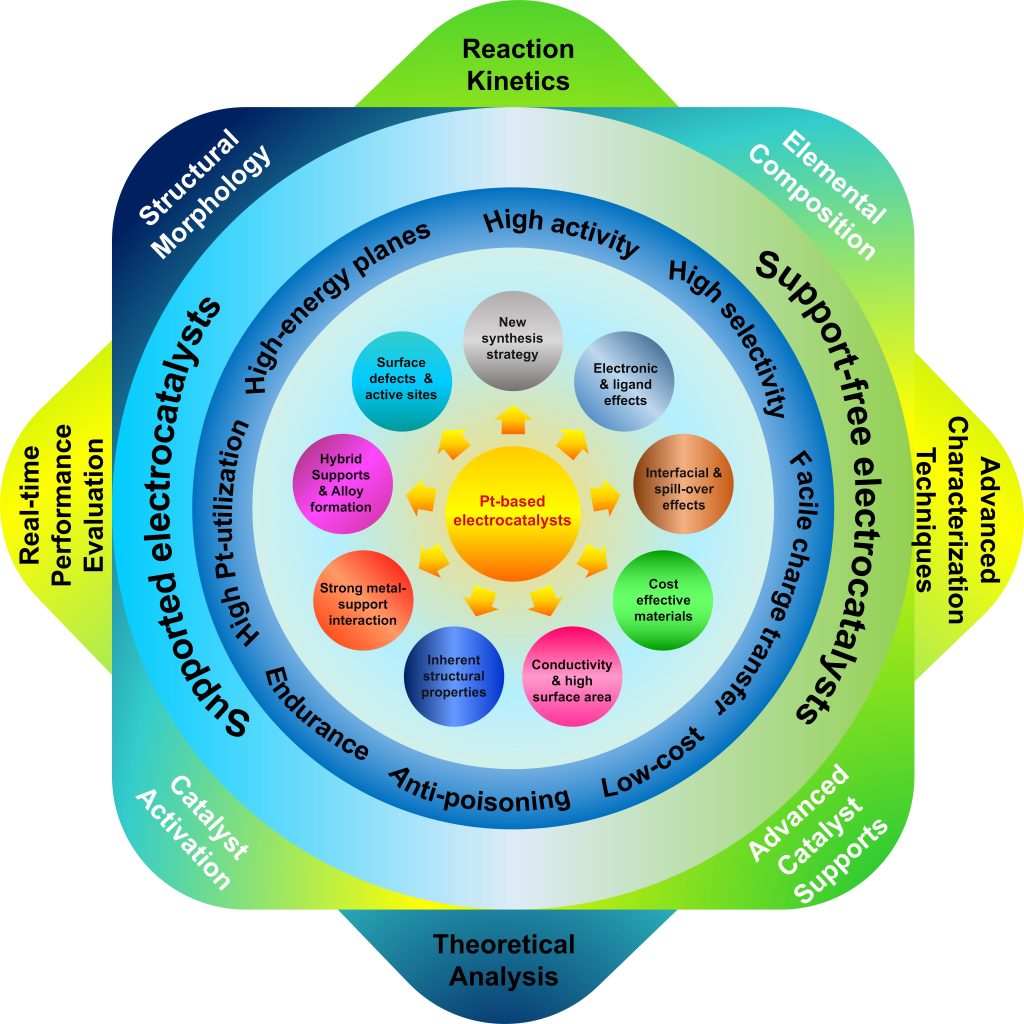
- Published in Departmental News, ENVS News, News, Research News


